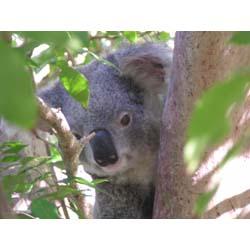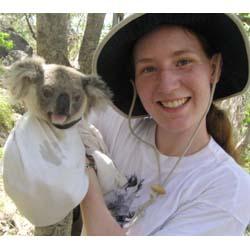Koala Centre renews partnership with Earthwatch
Published on 29 March, 2005
Central Queensland University's (CQU) Koala Research Centre will commit its operations on St Bees Island, near Mackay in Central Queensland, to another four-year research program with Earthwatch Corporation.
The research partnership, set to be renewed in May, has allowed more than 130 trained volunteers from around the world to take part in the University's koala research projects on the Island over the past four years.
Volunteers have been involved in koala tracking and field ecology. Volunteers are taught to radio track and sample the vegetation then work in teams to track the koalas each day during a trip. They are also involved in all the koala catching for morphometric measurements, changing collars and tagging new animals. They measure vegetation in different 'koala habitat' on the Island, help students gather data specific for their projects and do systematic searches looking for tagged and untagged koalas.
 Earthwatch conduct about four trips to the Island each year with 15 trips staged to date. Volunteers have come from around Australia (15) and around the world, including the US (76), UK (14), Singapore (10), Europe (5), Asia (5), Africa (2), Bermuda (2), South America (2) and Canada (1).
Earthwatch conduct about four trips to the Island each year with 15 trips staged to date. Volunteers have come from around Australia (15) and around the world, including the US (76), UK (14), Singapore (10), Europe (5), Asia (5), Africa (2), Bermuda (2), South America (2) and Canada (1).
Koala Research Centre's Dr Alistair Melzer said there has always been a big interest in the project.
"Our trips are usually booked well in advance and are generally filled to capacity. We hope this continues for the next four years.".
St Bees Island is a tropical island that experiences a distinctly different climate to any other area where koalas have been studied to date. As such it presents the possibilities of finding unique responses to the environment by koalas.
The Island's research operations is led by Dr Alistair Melzer (CQU) and Dr William Ellis (University of Queensland) who are investigating this healthy, unmanaged koala population to establish what the island’s koala carrying capacity is and to compare this in areas where management of koala populations has not been successful.
"On the Island we are looking into all aspects of the ecology of the koala population - what trees they use, where and how they move around the habitat, when and how frequently they breed, how long they live, how they die, do they have any diseases, what are the genetics of the population. So far we are just starting to answer these questions," Dr Melzer explained.
The most recent trip, held from January 27 to February 8, saw nine volunteers visit the Island. The group sampled vegetation in a new area of the island, trialled a new radio collar for PhD student Delma's Clifton's project and tracked all the animals.
 Radio transmitting collars on koalas are being used to indicate both movement and temperate changes in the habitat. When matched with environmental conditions at the time, the tracking results indicate whether the koalas prefer to roost in non-food trees during summer as some sort of adaptation to their microenvironment.
Radio transmitting collars on koalas are being used to indicate both movement and temperate changes in the habitat. When matched with environmental conditions at the time, the tracking results indicate whether the koalas prefer to roost in non-food trees during summer as some sort of adaptation to their microenvironment.
Ms Clifton said a better understanding of koalas’ use of microenvironments would inform future decisions on habitat classification and conservation plans.
“It will be proposed that three factors should be included in assessment of suitable koala habitat ... the presence of food trees, vegetation structure and microclimate,” Ms Clifton said.
Ms Clifton said the study would also focus on the koalas’ water use to find the exact advantage gained through the use of non-eucalypts.
“This is an important aspect of koala habitat that has not previously been considered in development of habitat suitability models.”.
Photo top: Earthwatch volunteer Corinne Kendall has a close encounter with a female koala known as Umbrella.

